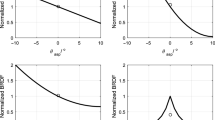Abstract
The surface bidirectional reflectance factor (BRF) is the ratio between reflected radiance measured in specific observation geometry (zenith and azimuth) within an infinitely small solid angle and irradiance incident on the surface from a direct source of illumination (zenith and azimuth). The BRF is determined from satellite observations through an atmospheric correction (AC) process. When properly retrieved, the surface BRF is fully decoupled from an atmospheric signal, and thus represents the value as measured by an ideal sensor held at the same view geometry and located just above the Earth’s surface assuming an absence of atmosphere.
Access this chapter
Tax calculation will be finalised at checkout
Purchases are for personal use only
Similar content being viewed by others
References
Coulson KL, Dave JV, Sekera Z (1960) Tables related to radiation emerging from a planetary atmosphere with Rayleigh scattering. University of California Press, Berkley.
Deschamps PY, Herman M, Tanré D (1983) Modeling of the atmospheric effects and its applications to the remote sensing of ocean color. Appl Opt 22(23):3751–3758.
Gao BC, Kaufman YJ (2003) Water vapor retrievals using Moderate Resolution Imaging Spectroradiometer (MODIS) near-infrared channels. J Geophys Res 108(D13):4389, doi.:10.1029/2002JD0003023.
Holben BN, Eck TF, Slutsker I, Tanré D, Buis JP, Setzerm A, Vermote EF, Reagan JA, Kaufman Y, Nakajima T, Lavenu F, Jankowiak I, Smirnov A (1998) AERONET – a federated instrument network and data archive for aerosol characterization. Remote Sens Environ 66:1–16.
Hsu NC, Tsay SC, King MD, Herman JR (2004) Aerosol properties over bright reflecting source regions. IEEE Trans Geosci Remote Sens 42(3):557–569.
Imager (2008) http://modis-sr.ltdri.org (click on ‘Software’). Accessed 31 Jan 2008.
Kaufman YJ, Tanré D, Remer L, Vermote EF, Chu A, Holben BN (1997) Operational remote sensing of tropospheric aerosol over land from EOS Moderate Resolution Imaging Spectroradiometer. J Geophys Res 102(14):17051–17068.
Kotchenova SY, Vermote EF (2007) Validation of a vector version of the 6S radiative transfer code for atmospheric correction of satellite data. Part II: Homogeneous Lambertian and anisotropic surfaces. Appl Opt 46(20):4455–4464.
Kotchenova SY, Vermote EF, Matarrese R, Klemm F Jr. (2006) Validation of a vector version of the 6S radiative transfer code for atmospheric correction of satellite data. Part I: Path Radiance. Appl Opt 45(26):6726–6774.
Levy RC, Remer LA, Mattoo S, Vermote EF, Kaufman Y (2007) Second-generation operational algorithm: Retrieval of aerosol properties over land from inversion of MODIS spectral reflectance. J Geophys Res 112:D13211, doi:10.1029/2006JD007811.
Lyapustin A, Wang Y (2007) MAIAC: Multi-Angle implementation of atmospheric correction for MODIS. Algorithm Theoretical Basis Document, 69 http://neptune.gsfc.nasa.gov/bsb/subpages/index.php?section=Projects&content=MAIAC%20ATDB Accessed 31 Jan 2008.
MODIS Land Quality Assessment (2008) Web site http://landweb.nascom.nasa.gov/cgi-bin/QA_WWW/newPage.cgi Accessed 31 Jan 2008.
Muldashev TZ, Lyapustin AI, Sultangazin UM (1999) Spherical harmonics method in the problem of radiative transfer in the atmosphere-surface system. J Quant Spectrosc Radiat Transf 61(3):393–404.
NASA’s Total Ozone Mapping Spectrometer (TOMS) (2008) Web site http://toms.gsfc.nasa.gov Accessed 31 Jan 2008.
National Center for Environmental Prediction Global Data Assimilation System (NCEP GDAS) (2008) http://wwwt.emc.ncep.noaa.gov/gmb/gdas/ Accessed 31 Jan 2008.
Remer LA, Kaufman YJ, Tanré D, Mattoo S, Chu DA, Martins JV, Li R-R, Ichoku C, Levy RC, Kleidman RG, Eck TF, Vermote EF, Holben BN (2005) The MODIS aerosol algorithm, products and validation. J Atmos Sc 62(4):947–973.
Terra MODIS Collection 5 Surface Reflectance Evaluation (2003 time-series science test analysis) http://mod09val.ltdri.org/cgi-bin/mod09_c005_public_allsites_onecollection.cgi Accessed 31 Jan 2008.
U.S. Geological Survey (2008) http://edcdaac.usgs.gov/gtopo30/gtopo30.asp Accessed 31 Jan 2008.
Vermote EF, Saleous NZ (2006) Operational atmospheric correction of MODIS visible to middle infrared land surface data in the case of an infinite Lambertian target. In: Qu JJ,Gao W, Kafatos M, Murphy RE, Salomonson VV (eds) Earth science satellite remote sensing, science and instruments, Tsinghua University Press/Springer, Beijing/Berlin 1, ch. 8, pp. 123–153.
Vermote EF, Vermeulen A (1999) MODIS atmospheric correction over land: surface reflectance. Algorithm Theoretical Background Document, Version 4.0. http://modis-sr.ltdri.org (click “Products and User’s Guide”). Accessed 31 Jan 2008.
Vermote EF, Tanré D, Deuzé JL, Herman M, Morcrette JJ (1997) Second simulation of the satellite signal in the solar spectrum, 6S: an overview. IEEE Trans Geosci Remote Sens 35(3):675–686.
Vermote EF, Tanré D, Deuzé JL, Herman M, Morcrette JJ, Kotchenova SY, Miura T (2006) Second simulation of the satellite signal in the solar spectrum (6S), 6S User Guide Version 3, http://6s.ltdri.org Accessed 31 Jan 2008.
Author information
Authors and Affiliations
Corresponding author
Editor information
Editors and Affiliations
Rights and permissions
Copyright information
© 2010 Springer Science+Business Media, LLC
About this chapter
Cite this chapter
Vermote, E., Kotchenova, S. (2010). MODIS Directional Surface Reflectance Product: Method, Error Estimates and Validation. In: Ramachandran, B., Justice, C., Abrams, M. (eds) Land Remote Sensing and Global Environmental Change. Remote Sensing and Digital Image Processing, vol 11. Springer, New York, NY. https://doi.org/10.1007/978-1-4419-6749-7_23
Download citation
DOI: https://doi.org/10.1007/978-1-4419-6749-7_23
Published:
Publisher Name: Springer, New York, NY
Print ISBN: 978-1-4419-6748-0
Online ISBN: 978-1-4419-6749-7
eBook Packages: Earth and Environmental ScienceEarth and Environmental Science (R0)




